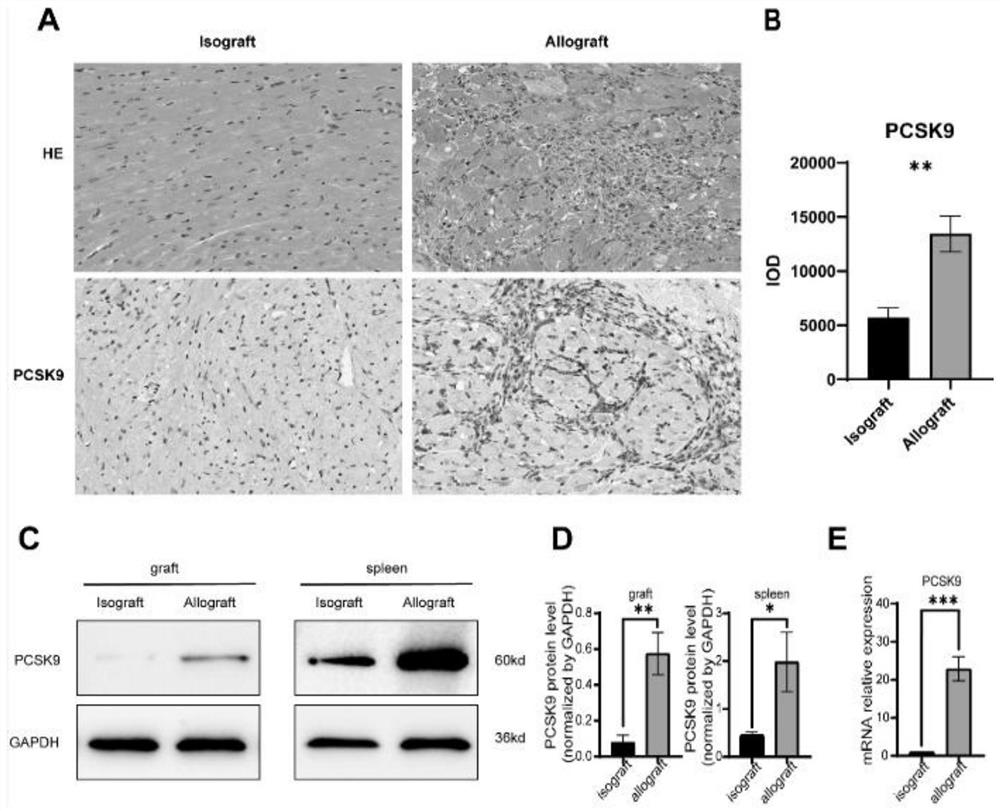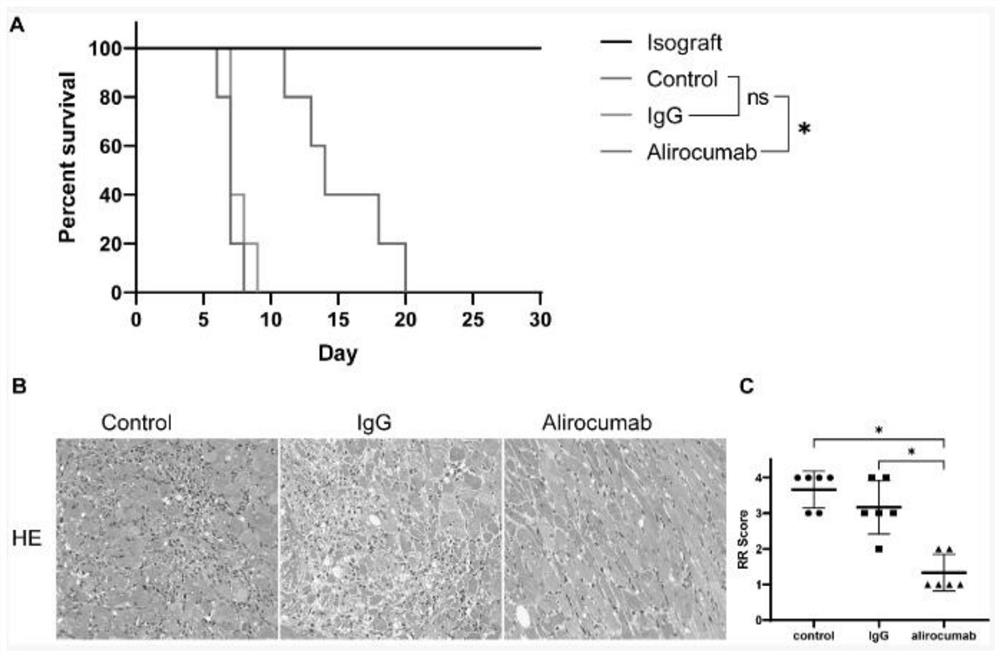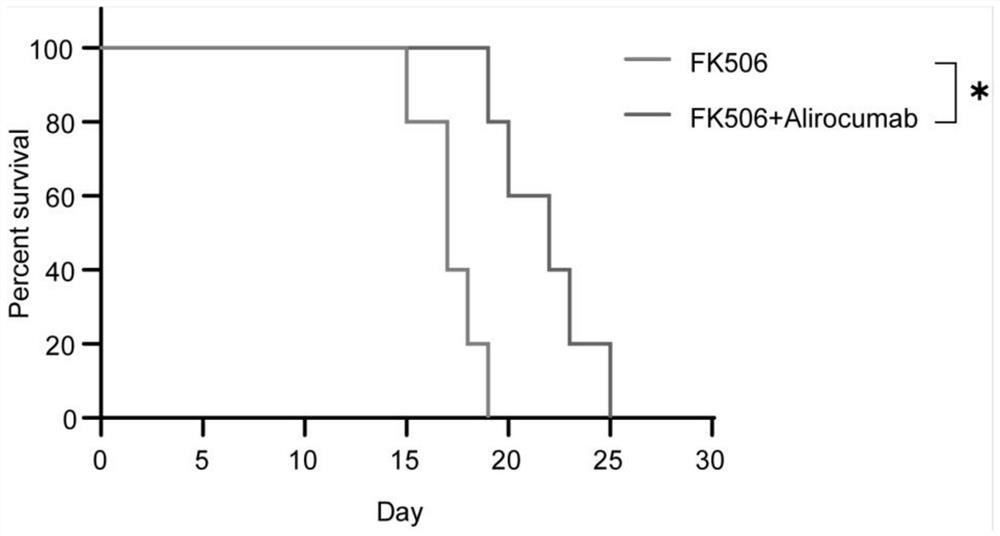Application of PCSK9 inhibitor in anti-rejection after cardiac transplantation
A technology for heart transplantation and rejection, applied in the medical field, can solve problems such as infection, no anti-rejection treatment, neurotoxicity, etc., and achieve the effect of prolonging the survival period, reducing graft rejection, and prolonging survival time
- Summary
- Abstract
- Description
- Claims
- Application Information
AI Technical Summary
Problems solved by technology
Method used
Image
Examples
experiment example 1
[0032] Step 1, select sample mice, the number is forty. Among them, 20 donor mice (BALB / c) and 20 recipient mice (C57BL / 6);
[0033] Step 2. Select ten recipient mice to establish a heart transplant animal model, and detect the expression of PCSK9 in the transplanted heart and spleen seven days after the transplantation;
[0034] Step 3. Establish a heart transplantation model in another ten recipient mice, and the recipient mice receive ariroclizumab injection 24 hours before the operation, and observe the beating state of the transplanted heart of the mice after transplantation;
[0035] Step 4: From the first day after the transplantation, the mice were continued to be injected with arilocumab, and the beating state of the transplanted heart of the mice was observed daily thereafter. The complete cessation of beating of the transplanted heart was the end of the experiment, and the survival time of the graft was recorded;
[0036] in:
[0037] The dose of arirocurumab inj...
experiment example 2
[0041] The use of immunosuppressants alone in anti-rejection after heart transplantation:
[0042] Step 1, the selected immunosuppressant, preferably FK506;
[0043] Step 2, select sample mice, the number is 20. Among them, ten donor mice (BALB / c) and ten recipient mice (C57BL / 6);
[0044] Step 3. Establish a heart transplant model in ten recipient mice, and observe the beating state of the transplanted heart of the mice after transplantation;
[0045] Step 4: Intraperitoneal injection of FK506 was performed on the first day after transplantation, and the beating state of the transplanted heart of mice was observed daily thereafter. The complete cessation of beating of the transplanted heart was the end of the experiment, and the survival time of the graft was recorded;
[0046] in:
[0047] The dosage of FK506 is 1mg / kg / day, the mass of the injected body is 25-30mg, and the injection method of FK506 is intraperitoneal injection;
[0048] Step 5, on the 7th day and the 14...
experiment example 3
[0051] Combination of PCSK9 inhibitor and FK506 in anti-rejection after heart transplantation:
[0052] Step 1. The selected PCSK9 inhibitor is preferably arirocurumab, and the immunosuppressant is selected, preferably FK506;
[0053] Step 2, select sample mice, the number is 20. Among them, ten donor mice (BALB / c) and ten recipient mice (C57BL / 6);
[0054] Step 3. Ten recipient mice were established as heart transplantation models, and 24 small recipient mice were injected with arirocurumab before surgery, and the beating state of the transplanted hearts of the mice was observed after transplantation;
[0055] Step 4: From the first day after the transplantation, the mice were injected with arirociumab and FK506, and the beating state of the transplanted heart of the mice was observed daily thereafter. The complete cessation of beating of the transplanted heart was the end of the experiment, and the survival time of the graft was recorded;
[0056] in:
[0057] The dose o...
PUM
 Login to View More
Login to View More Abstract
Description
Claims
Application Information
 Login to View More
Login to View More - R&D
- Intellectual Property
- Life Sciences
- Materials
- Tech Scout
- Unparalleled Data Quality
- Higher Quality Content
- 60% Fewer Hallucinations
Browse by: Latest US Patents, China's latest patents, Technical Efficacy Thesaurus, Application Domain, Technology Topic, Popular Technical Reports.
© 2025 PatSnap. All rights reserved.Legal|Privacy policy|Modern Slavery Act Transparency Statement|Sitemap|About US| Contact US: help@patsnap.com



